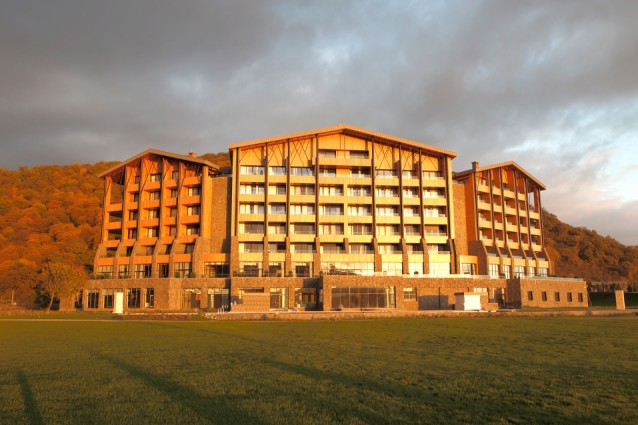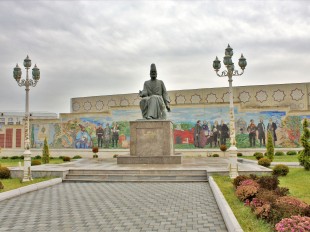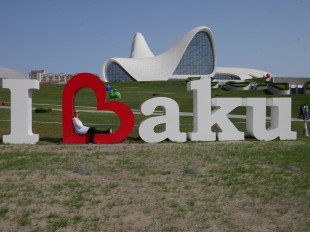In sylvan countryside near the foothill resort town of Qabala, the mission of the ultra-luxurious Chenot Palace Spa is to take bodies that have been worn down with too much work, lamb, vodka or pakhlava, and rejuvenate them with a highly medicalised programme of diet, massage, exercise and some of the most hi-tech treatment technologies anywhere. Think ultra-luxurious hospital but without drugs. Travel writers Mark Elliott and Sally Cobham gave it a try.
Set in acres of lakeside lawns, the Chenot Palace is one of Azerbaijan’s most exclusive retreats. The interior, crafted by international designer Michel Jouannet, oozes taste – very contemporary and light-touch with artfully placed vases and intriguing glimpsed spaces. The lobby centrepiece is somewhere between table and sculpture fashioned from a huge cross-section of rooted tree-base. Soothingly coloured corridors are decked with subtle Rəşad paintings interspersed by gilded three-dimensional neem-leaf collages. Every bedroom has a generous balcony overlooking Nohur Lake, a restful sight backed with woodland hills and all merrily a-croak with frogs. Bedside lamps are works of modern art created from stacked towers of little stone squares. Should the superb cushion-piled bed not prove perfect for your sleeping comfort, there’s also a six-option menu of alternative pillows to aid your dozing – pine and Arven-chip perhaps? Or cherry-stone? Wheat? Or horsehair? Want your footwear polished before dinner? Sure – just call for a bespoke shoeshine signed John Lobb of London bootmakers, though hopefully they won’t take the shoes all the way to London’s Regent Street. Bathroom fittings seem designed to prove that no expense has been spared: his and hers side-by-side wash basins, tub AND shower, thick towelling gowns with beautifully embroidered logos, family-sized tubes of exclusive Chenot-branded toiletries... even the provided combs are full-sized and made of wood. Super- soft toilet paper is folded with a special origami-esque closure and a logoed sticker. The very well-made zip-bag provided to carry your accoutrements around the resort during your stay is free to take home afterwards and would make a great souvenir in itself.
caffeine, like alcohol, chocolate and so much more is off-limits from the chenot diet. Welcome to detox deluxe
Detox deluxe
OK so it’s clear that this is a great hotel. But what’s completely different here is the whole therapeutic premise of the place. In case you hadn’t realised before checking in (there’s a three-day minimum stay), a couple of clues lie in the room. First look in the minibar. No miniature Gordons or snickers bars here. The choice is water or water. Half a dozen bottles with a choice of flat or flat, just different brands. Then there’s no kettle. That’s because caffeine, like alcohol, choco- late and so much more is off-limits from the Chenot diet. Welcome to detox deluxe.
For guests, none of this is a surprise. A majority of them, mostly Russian and Kazakh, are already very familiar with the special rigours of the Henri Chenot method (www.chenot.com) from previous stays in Chenot’s base hotel in Merano, Italy. The Qabala version offers them a similar approach but even greater luxury and the reassurance of multilingual staff who understand Russian, though, explains urbane Dr Teymur as he explains the system in more detail, finding a translation for ‘wellness’ as distinct from ‘health’ is actually rather awkward in Russian.
The first afternoon of any Chenot stay starts with a series of medical check-ups and analyses. For these we have moved into the resort’s treatments area. In startling contrast to the padded pampering of the main hotel section, this zone has a neatly clinical feel. A special receptionist sits at what feels like a portal to a futuristic space station. Consulting rooms could be Clockwork Orange movie sets with white-on-white décor matched by the doctors’ perfectly starched high-necked uniforms.
My ‘BioEnergetic checkup’ is managed by a UK-trained Greek osteopathist who learnt acupuncture and tongue analysis in China and ‘visceral manipulation’ in Ukraine. Visceral what? I choke? Apparently it’s possible to cure certain shoulder pains simply by jiggling the kidneys in three dimensions. Anyway, today he is to give me an ‘Energetic Baseline Report’ using a deceptively simple-looking machine that looks like a portable hotplate, albeit with gilded handles and several electronic buttons. Apparently these cost $19,000 a pop. And the resort has three. Then there’s a puffed up arm band placed around my upper arm, creating a curious squeezing then pulsing feeling while relating a whole range of data about the state of my arteries. Then infrared thermal imaging creates a series of colour-coded photos of my body’s heat emanations suggesting neck ache. Clever, and very true. I feel grudgingly impressed. I hadn’t mentioned those pains in the initial chat.
I lie down on a bed while scanned by what appears to be a giant photocopier
Of all the afternoon’s tests, the visit to one’s assigned nutritionist is arguably the most significant stage in a Chenot preparation as it will decide the diet on which a guest will eek out their calories in the meals to follow. I lie down on a bed while scanned by what appears to be a giant photocopier. After much rattling and jerking the machine spits out data with a bone density map of my skeleton and the percentile of tissue fat. Apparently my ‘G’ (gynoid fat, i.e. around the hips) is OK but the ‘A’ (android fat) is less encouraging. Surely androids don’t get fat at all, I quip. But in fact I’m just being told that I’ve got a bit of a belly. So, what I need is the detox diet. That’s 700 calories a day without meat, dairy, salt or potatoes. The ‘easier’ alternative, ‘bio-lite,’ would only have been very slightly more forgiving.
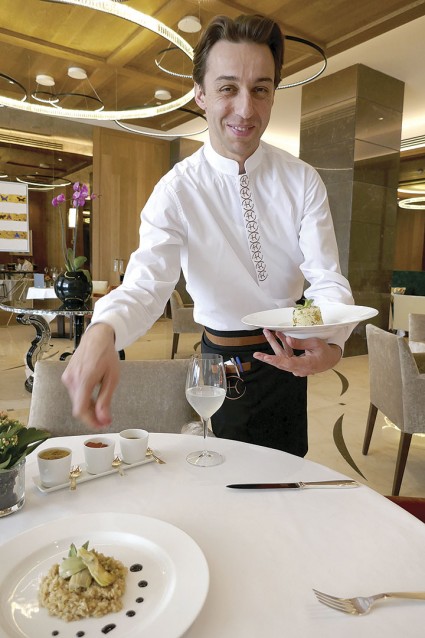 What it lacks in calories, the cuisine makes up in beautiful presentation and cheerful service. Photo: Mark Elliott
What it lacks in calories, the cuisine makes up in beautiful presentation and cheerful service. Photo: Mark Elliott
Soon enough it’s time to see what 700 calories actually mean on my plate. On reaching the suave dining room we are told ceremoniously that A table has been selected for you. This will remain our spot for the rest of our stay – all part of removing the annoyances of decision-making while one ‘works’ at relaxing. The table is laid with beautiful starched linen napkins and fine if stylishly simple Bernardaud china from Limoges. The gleaming, heavy Gio Ponti silverware is from Sambonet. I Google the brand and note that the five-piece set is worth $85, as much as many a decent local hotel. Then there are large Italesse wine glasses. But rather than wine, the choice of beverage is water, lemon water or – for the most daring – water with a dash of cider vinegar.
The delicious, essentially vegan meal starts with a ‘cannelloni’ of thin-sliced kohlrabi, stuffed with aubergine paste and served with a beetroot jus and a sprig of mint. Then vegetable soup which has a great subtlety but as with all the food, avoids dairy products. Neither salt or pepper is incorporated, nor available as condiments, but instead a palate of paprika, cumin and curry powder allows diners to add colour and extra umph. For main course there is an excellent fine couscous incorporating nuts and raisins, albeit about one cupful in total – about as much as you’d expect to find as a very modest side dish in a nouvelle cuisine restaurant.
The floor manager, poached from the prestigious Fairmont chain, chats easily with the various guests. He shows us photos of his glamorous young wife and admits how tough it is to be separated so soon in their relationship. But how is the food? he asks. It’s undoubtedly presented with extraordinary panache and, given the extreme strictures of sticking to 700 calories, the delicious dishes are remarkably imaginative. But my stomach is begging for more. It’s normal on the first day he accepts. The trick is to chew every mouthful at least 30 times.
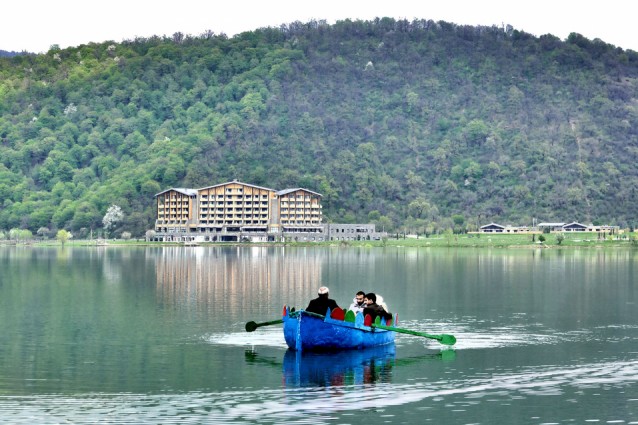 The Chenot resort as seen from Sahil, a restaurant and area of less exclusive tourist activities at the western edge of Nohur Lake. Photo: Mark Elliott
The Chenot resort as seen from Sahil, a restaurant and area of less exclusive tourist activities at the western edge of Nohur Lake. Photo: Mark Elliott
After a few days, I can imagine the temptation guests must feel to sneak away for a secret snack. Around 600m from the resort there’s a roadside tea-place where the entrancing smells of fresh bread will be wafting from the tandir oven. Nearer still is a kebab garden – imagining the luscious smells of barbequing lamb is a self-inflicted torture. But then to get out of the complex there are forbiddingly gigantic modernist wrought iron gates to get past, made all the more impenetrable by electronic anti-ram bollards. Sure, the guards would slowly swing them open on request. But asking would feel like a guilty loss of face.
In fact most guests do persevere, sipping barley based coffee-substitutes, special Chenot caffeine-free tea-blends and retiring at night to the bar where the main indulgence is a range of almond-milk fruit smoothies. In fact most week-long detox programmes add in an even more rigorous ‘fast-day.’ That starts one dinner time when, instead of your seitan and quinoa, you receive a calorie-less soup that’s simply vegetable stock along with some magnesium salts to prepare your body for the cleansing ahead. Breakfast next day is just a special juice of cucumber and greens. Then lunch again is veg stock. To celebrate your 24 hours free of calories, dinner that evening will be a fish dish – though don’t expect chips with that.
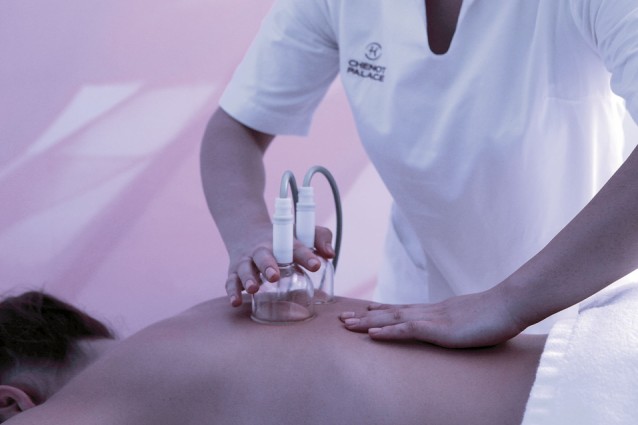 A multi-national team of professional physiotherapists and masseuses use a range of techniques to soothe away your stress. Photo: courtesy of Chenot Palace
A multi-national team of professional physiotherapists and masseuses use a range of techniques to soothe away your stress. Photo: courtesy of Chenot Palace
Wacky treatments
We won’t be staying that long. But we will get to try a few of the more interesting ‘treatments.’ A popular choice is hydro-therapy involving big baths full of water jets, essential oils and coloured lights that shine with what your earlier analysis has revealed to be ‘your colour’ (mine apparently has been recognised as blue, though I’m free to request an alternative). All this apparently encourages lymphatic circulation. Then there are six phyto-mud sessions, where they use a big paintbrush to cover you with warm goo on a water filled mattress, wrap you in plastic, cover you with a big duvet and leave you for half an hour to sweat out some toxins. Hydrojet sessions then direct a fireman’s hose at you to get rid of the mud and tone up your tissues, starting with warm water and then, if you are brave, following up with a blast of freezing cold to reinvigorate. You might also get six hours of amazing deep-tissue massages. Several of the masseuses are from Bali and have worked all over the world, offering a wide range of styles. I get to try one that involves curious glass cups.
Then, as though I’m a Frankenstein project, he pulls out long cables from a draw beneath the couch, plugs them in, and starts to play with a series of dials
Far stranger is a form of hi-tech electronic massage. The weird set up feels like a classic James Bond villain’s experiment. The physiotherapist-operator is another Greek, whose demeanour does nothing to diminish the sentiments. James Bond? Hahahahahaha. He laughs exaggeratedly. Your wife said the same thing. He spreads lubricants on a series of electrode pads. I will place them under your neck and between your scapulas, he says chortling rather manically. Then, as though I’m a Frankenstein project, he pulls out long cables from a draw beneath the couch, plugs them in, and starts to play with a series of dials. As music plays through my earphones he adjusts the intensity and a curious series of sensations pass through me feeling at times like a rapid-fire massage, an oscillating wave and sometimes a pleasant version of pins and needles. Apparently electromagnetic oscillations are causing vibrations in my cells – different frequencies having positive effects on different factors in the body. Very strange but soothing and unmissably fascinating.
And there’s so much more, a gorgeous infinity pool that never seems to have anyone in it. An even bigger outdoor pool. A workout with lake view, saunas, hamams, a reduced oxygen room to simulate altitude training, top-quality pilates benches and an anti-gravity treadmill that allows the infirm or seriously obese to exercise without damaging their joints.
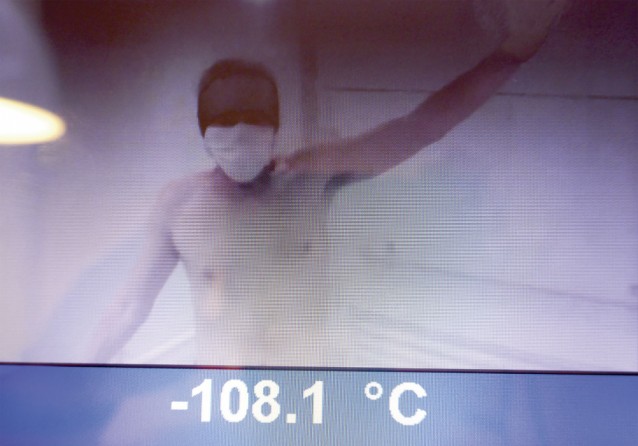 The cryogenic chamber is colder than the coldest place on earth… and one enters in shorts. Photo: Mark Elliott
The cryogenic chamber is colder than the coldest place on earth… and one enters in shorts. Photo: Mark Elliott
But before leaving I really want to try the most scarily sci-fi treatment of them all - the Cryogenic Room. This is a trio of interconnected chambers in which you experience a temperature colder than even Siberia’s most frigid winter record holder. And do so in shorts. So I strip off. It’s best to wear training shoes, I’m warned. Toes and fingernails are the first things that freeze if you get frostbite. I also put on gloves and a mask to stop my breath freezing. Then I venture into the first of three giant freezers. First -10 degrees for 20 seconds. Then -55 degrees for a few seconds more. Now how long can I stay at -108 degrees? It’s cold. But oddly invigorating. And a big emergency handle is there just in case I panic and want to escape.
Did it really improve my circulation? Well hard to say. As we were told repeatedly, none of the individual parts should be seen in isolation. Guests need to stay at least three days. Ideally a week or more to get the benefits of the diet, the treatments and the relaxation potential. But even our brief stay was long enough to experience something fascinating, invigorating and completely unique.
About the author: Mark Elliott is a travel writer who has been covering Azerbaijan since 1995. The fifth edition of his guidebook is currently being edited for publication later this year.